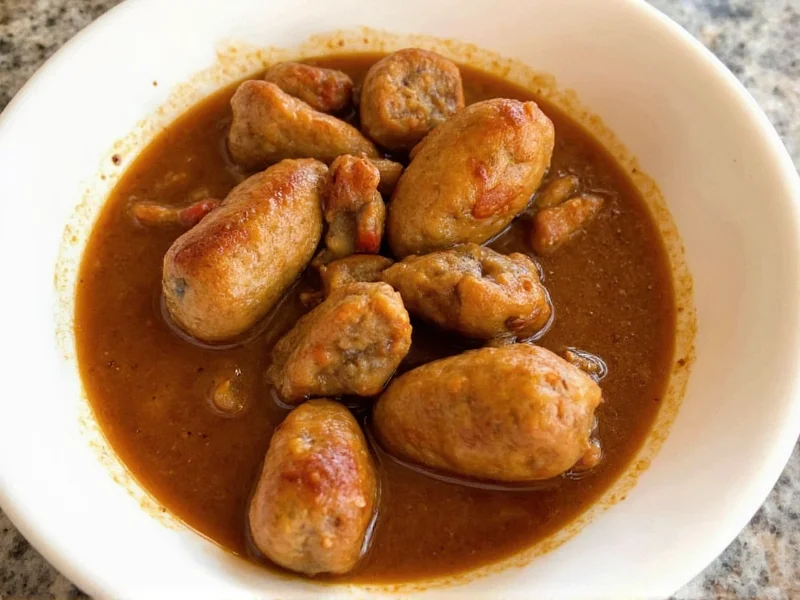The Cultural Roots of Sausage Chicken Gumbo
Gumbo's origins trace back to 18th century Louisiana, where French, African, Spanish, and Choctaw culinary traditions converged. The word 'gumbo' derives from the West African term for okra, reflecting its African influence. While seafood gumbo appears in coastal regions, sausage chicken gumbo became popular in inland Louisiana where poultry and smoked meats were more accessible. This versatile dish evolved as a 'kitchen sink' meal, incorporating whatever ingredients were available while maintaining its distinctive roux-based foundation.
Essential Ingredients for Authentic Flavor
The magic of a perfect sausage chicken gumbo lies in its layered ingredients. Understanding traditional components helps achieve authentic results while allowing for thoughtful variations.
| Ingredient Category | Traditional Options | Quality Indicators |
|---|---|---|
| Proteins | Andouille sausage, chicken thighs, tasso ham | Smoked meats with visible fat marbling |
| Roux Base | All-purpose flour, vegetable oil or bacon fat | Dark chocolate color for traditional flavor |
| Holy Trinity | Onions, celery, green bell peppers (equal parts) | Fresh, firm vegetables with vibrant color |
| Thickening Agents | Okra or filé powder | Fresh okra pods or pure sassafras filé |
| Seasonings | Cayenne, thyme, bay leaves, garlic | Fresh herbs preferred over dried when possible |
Mastering the Roux: Gumbo's Foundation
No element defines gumbo more than its roux. This simple mixture of fat and flour requires patience but delivers unparalleled depth. For sausage chicken gumbo, aim for a dark chocolate-colored roux, which takes approximately 25-35 minutes of constant stirring. Many home cooks make the mistake of rushing this process, resulting in a bland base. The ideal roux develops nutty, complex flavors while providing essential thickening. When preparing your roux, maintain medium heat and stir continuously in a figure-eight pattern to prevent burning. The moment it reaches your desired color, immediately add the holy trinity vegetables to stop the cooking process.
Step-by-Step Cooking Process
Preparing Your Ingredients
Before beginning, properly prepare all components. Cut chicken thighs into 1.5-inch pieces, slice smoked sausage into half-moons, and dice the holy trinity vegetables uniformly. Having everything ready before making the roux prevents rushed decisions that could compromise your gumbo's quality. This mise en place approach ensures smooth transitions between cooking stages.
Building Flavor Layers
After completing your roux and adding the holy trinity, cook until vegetables soften (about 8-10 minutes). Next, brown your chicken pieces in batches, removing them once seared. Sauté the sausage until it releases its oils, then return all meats to the pot. Add chicken stock gradually, stirring constantly to incorporate the roux fully. Include tomatoes (optional in some traditions), garlic, and seasonings. Simmer uncovered for 1.5-2 hours, allowing flavors to meld while maintaining a gentle bubble.
Perfecting Your Gumbo: Expert Techniques
Professional chefs emphasize several techniques that transform good gumbo into exceptional. First, use homemade chicken stock when possible - the gelatin content improves mouthfeel significantly. Second, incorporate the 'resting period' concept: prepare your gumbo one day ahead, as flavors deepen overnight. Third, add filé powder only at serving time, never during cooking, as it becomes stringy when boiled. Finally, adjust seasoning gradually throughout cooking, remembering that flavors concentrate as liquid reduces.
Common Variations and Substitutions
While traditional sausage chicken gumbo follows specific guidelines, thoughtful adaptations maintain authenticity while accommodating different needs. For gluten-free versions, use rice flour for the roux. Vegetarian adaptations substitute mushrooms and extra okra for meat, though this creates a fundamentally different dish. Some home cooks add a splash of sherry for complexity, while others include a small amount of Worcestershire sauce for umami depth. The key to successful variations is understanding which elements are essential to gumbo's identity versus those that allow flexibility.
Serving Traditions and Pairings
Authentic gumbo service follows specific customs that enhance the experience. Always serve over steamed long-grain white rice, never mixed together. Offer file powder and hot sauce on the side for customization. Traditional accompaniments include potato salad (a surprising but classic pairing in Louisiana) and French bread for soaking up every drop. For beverages, a crisp lager or dry white wine complements the rich flavors without overwhelming them. When presenting, use wide, shallow bowls that showcase the gumbo's texture and color.
Troubleshooting Common Gumbo Issues
Even experienced cooks encounter challenges with gumbo. If your roux burns, start over - no amount of scraping will salvage it. For a gumbo that's too thin, continue simmering to reduce liquid or prepare a small additional roux to thicken. If too thick, add warm stock gradually. When flavors seem flat, try adding a small amount of acid (lemon juice or vinegar) to brighten the profile. For overly spicy gumbo, incorporate more vegetables or a touch of sugar to balance heat. Remember that gumbo often improves after resting, so avoid final seasoning adjustments until the next day.
Storage and Reheating Best Practices
Gumbo freezes exceptionally well, making it ideal for meal preparation. Cool completely before storing in airtight containers, leaving one inch of headspace for expansion. Properly stored, it maintains quality for up to three months. When reheating, thaw overnight in the refrigerator, then warm gently on the stove over medium-low heat. Avoid boiling, which can cause the chicken to become tough. If the gumbo has thickened excessively during storage, add a small amount of chicken stock while reheating. Never microwave gumbo, as uneven heating compromises both texture and flavor distribution.











 浙公网安备
33010002000092号
浙公网安备
33010002000092号 浙B2-20120091-4
浙B2-20120091-4